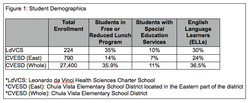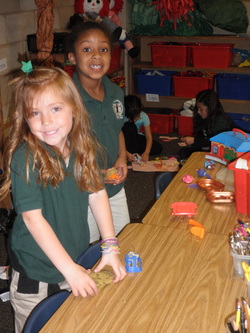School Setting
I teach at Leonardo da Vinci Health Sciences Charter School (LdV). We are an independent Kindergarten through sixth grade charter school located in Chula Vista, California. The school opened in the fall of 2009. It was the dream of a small group of teachers to establish a new charter school after their previous district conversion charter school chose to relinquish the charter.
LdV is located on the Mater Dei Catholic High School campus. However, we are not affiliated with the high school. We serve a very diverse community from all across San Diego County. Being a charter school, we do not have any set boundaries so our students commute from anywhere in San Diego. LdV is a very small school. When I began writing my proposal in the Spring of 2010 there were 156 students enrolled. Our enrollment for the 2010-2011 school year has increased to 224 students. This year we are 35% free or reduced lunch which is high in comparison with our surrounding community. We also have a high population of students that qualify for special education given the size of our total enrollment (10%).
LdV is located on the Mater Dei Catholic High School campus. However, we are not affiliated with the high school. We serve a very diverse community from all across San Diego County. Being a charter school, we do not have any set boundaries so our students commute from anywhere in San Diego. LdV is a very small school. When I began writing my proposal in the Spring of 2010 there were 156 students enrolled. Our enrollment for the 2010-2011 school year has increased to 224 students. This year we are 35% free or reduced lunch which is high in comparison with our surrounding community. We also have a high population of students that qualify for special education given the size of our total enrollment (10%).
The mission of LdV is to promote the knowledge, critical thinking skills, and attitudes that empower all students to become influential contributors in an ever-changing, global society. The instructional program is founded on inquiry, project-based learning, and supported by technology. Multiple learning modalities and cooperative learning strategies are employed to accommodate all learners, hopefully enabling students to achieve at their highest levels. LdV is founded on the principle that children should take pride in their cultural and linguistic heritage. We nurture acceptance and respect of cultural differences by helping students develop positive attitudes about, and behaviors toward people from backgrounds that are different from their own. Curriculum, policies, and practices embrace the full range of diversity present in society.
A major focus at LdV is parent involvement. Families are required to volunteer at least five hours of time to the school every semester. The requirement can be filled by working in a classroom, chaperoning on field trips, xeroxing copies, donating school supplies, joining one of the governance committees, or supervising recess and lunch. If a family is unable to fulfill the hours on campus arrangements can be made to have some home-based opportunities. It has been my experience that the more involved the families are at home, the more successful the student tends to be.
LdV has three self-contained kindergarten classrooms, two 1st Grades, one 2nd Grade, one 2nd-3rd Grade Combination, one 3rd Grade, one 4th Grade, one 5th Grade, and one 6th Grade. Teachers are able to teach to the needs of their students by collaborating across grade levels. Teachers’ room environments and instructional materials may vary from room to room to best reach the needs of the students in that particular room.
As a school, teachers focus on student ownership of learning and projects as opposed to typical text book activities. Teachers have the freedom with their curriculum and how they address the standards at their grade level, rather than simply following a prescribed pacing guide. However, we are all still held accountable to state standards in all grades and state testing in grades two through six.
LdV is a sciences-driven school. The teachers let science, social science, and health guide the learning with language arts embedded in the curriculum. We have a partnership with the Rueben H. Fleet Science Center in Balboa Park. This is a great opportunity for our students to participate in science activities unavailable to the public at the Fleet.
A major focus at LdV is parent involvement. Families are required to volunteer at least five hours of time to the school every semester. The requirement can be filled by working in a classroom, chaperoning on field trips, xeroxing copies, donating school supplies, joining one of the governance committees, or supervising recess and lunch. If a family is unable to fulfill the hours on campus arrangements can be made to have some home-based opportunities. It has been my experience that the more involved the families are at home, the more successful the student tends to be.
LdV has three self-contained kindergarten classrooms, two 1st Grades, one 2nd Grade, one 2nd-3rd Grade Combination, one 3rd Grade, one 4th Grade, one 5th Grade, and one 6th Grade. Teachers are able to teach to the needs of their students by collaborating across grade levels. Teachers’ room environments and instructional materials may vary from room to room to best reach the needs of the students in that particular room.
As a school, teachers focus on student ownership of learning and projects as opposed to typical text book activities. Teachers have the freedom with their curriculum and how they address the standards at their grade level, rather than simply following a prescribed pacing guide. However, we are all still held accountable to state standards in all grades and state testing in grades two through six.
LdV is a sciences-driven school. The teachers let science, social science, and health guide the learning with language arts embedded in the curriculum. We have a partnership with the Rueben H. Fleet Science Center in Balboa Park. This is a great opportunity for our students to participate in science activities unavailable to the public at the Fleet.
Classroom Setting
I am one of three kindergarten teachers at LdV. This is my second year teaching kindergarten and I know it is where I truly belong. I spent my previous years teaching first grade. My partners and I collaborate daily. We have a wonderful working relationship where each of us brings ideas to the table. We plan out our units together to have a unified kindergarten team. Kindergarten at LdV began the year on a Half Day Schedule (8:00-12:30). This allowed us to assess all students to get a clear baseline of skills. Each student was giving a 90 minute testing period after school with their parents present. The information I gathered and was able to relay to the parents was invaluable. It put everyone on the same page right at the beginning of the school year. We set goals and discussed interventions. After nine weeks of this Half Day Schedule we transitioned into a Full Day Schedule that was identical to the rest of the school: 8:00-3:00 Monday, Tuesday, Thursday, Friday, and 8:00-12:30 on Wednesdays. It is an extremely long day but our students see the benefit of all the extra learning time.
My classroom was not built for elementary students. It is a high school. Eventually we would like to build our own site but this is what we have for now, so we make do. My kindergartners are unable to reach the white boards without a step-stool and there are no bathrooms, drinking fountains, or sinks inside the room (which makes for some interesting messes). On a positive note, the room is huge. We have plenty of floor and wall space. I have five computers set up for student use and they use them daily. I have a projector set up and a doc-cam stationed in the front of the room. There is lots of storage space for myself and my students. Each student has a cubby to keep personal items in. Tables are placed around the classroom to create learning stations for students, and students are not assigned a table seat. A large rug is in the front of the room where most of the whole-group activities take place. There is a classroom library and a teacher desk area.
Monday mornings we have assemblies then school Families. Families are a community building program in which a teacher has a mixed group of students, K-6, that will be part of a team for the length of time enrolled at LdV. Tuesday-Friday all primary grades participate in Spanish class for 30 minutes. Since there are three kindergarten classes we have decided to split each class of 20 in half for Spanish and mix them so they have an opportunity to meet/learn with the other classes. The remaining ten students stay in the classroom and have small reading groups. Then the Spanish group and reading group switch and the process is repeated.
Everyday during the week students participate in a series of learning stations. These stations focus on areas across the curriculum including language arts, math, science, social science, technology, art, and health. Students are in cooperative groups (homogenous and heterogeneous depending on the daily activities) or work independently with teacher or parent-volunteer guidance. Students are also given at least 30 minutes of activity time during the day where they may play freely in the classroom and work on social skills. This is the perfect time for me to see if my students are using their conflict resolution skills and where I will take many of my anecdotal notes.
My classroom was not built for elementary students. It is a high school. Eventually we would like to build our own site but this is what we have for now, so we make do. My kindergartners are unable to reach the white boards without a step-stool and there are no bathrooms, drinking fountains, or sinks inside the room (which makes for some interesting messes). On a positive note, the room is huge. We have plenty of floor and wall space. I have five computers set up for student use and they use them daily. I have a projector set up and a doc-cam stationed in the front of the room. There is lots of storage space for myself and my students. Each student has a cubby to keep personal items in. Tables are placed around the classroom to create learning stations for students, and students are not assigned a table seat. A large rug is in the front of the room where most of the whole-group activities take place. There is a classroom library and a teacher desk area.
Monday mornings we have assemblies then school Families. Families are a community building program in which a teacher has a mixed group of students, K-6, that will be part of a team for the length of time enrolled at LdV. Tuesday-Friday all primary grades participate in Spanish class for 30 minutes. Since there are three kindergarten classes we have decided to split each class of 20 in half for Spanish and mix them so they have an opportunity to meet/learn with the other classes. The remaining ten students stay in the classroom and have small reading groups. Then the Spanish group and reading group switch and the process is repeated.
Everyday during the week students participate in a series of learning stations. These stations focus on areas across the curriculum including language arts, math, science, social science, technology, art, and health. Students are in cooperative groups (homogenous and heterogeneous depending on the daily activities) or work independently with teacher or parent-volunteer guidance. Students are also given at least 30 minutes of activity time during the day where they may play freely in the classroom and work on social skills. This is the perfect time for me to see if my students are using their conflict resolution skills and where I will take many of my anecdotal notes.


